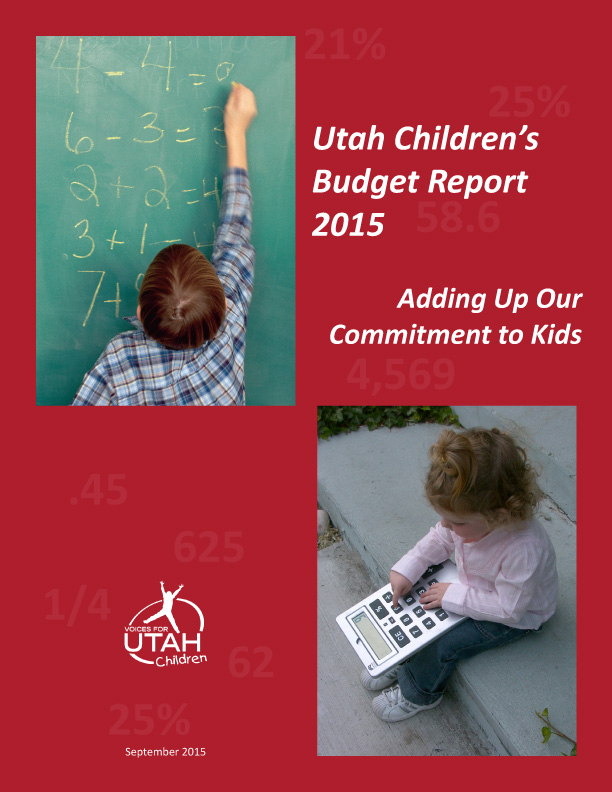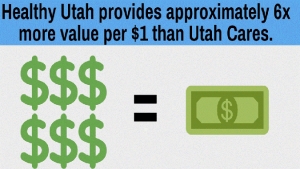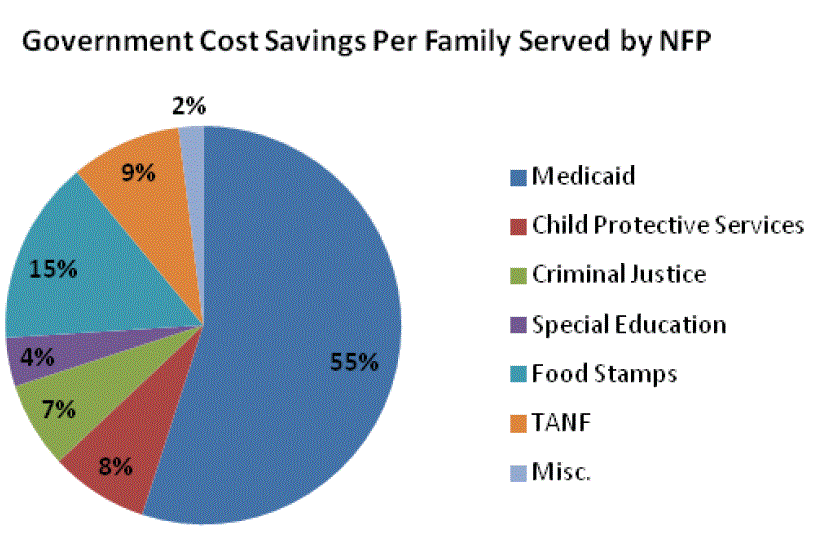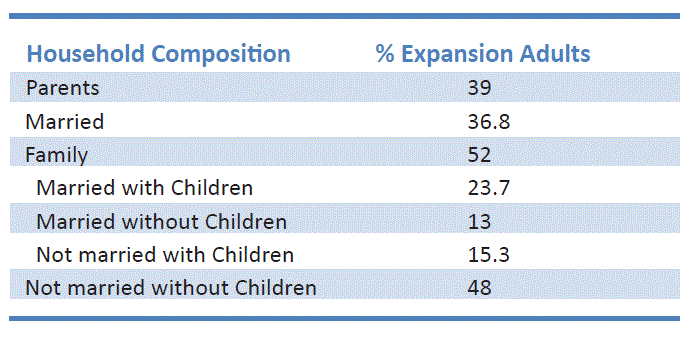Poverty
The 2015 Children's Budget Report: Adding Up Our Commitment to Kids
Why a “Children’s Budget”?
Children, it is often said, are Utah’s most precious resource. They represent the workforce, consumers, and leaders of tomorrow. For that reason, the investments we make in our children today have enormous economic and social implications for Utah’s future. That is why our federal, state, and local units of government pool taxpayers’ resources to establish an education system, provide for the health and other basic needs of our most vulnerable children, and intervene in children’s lives when their safety is at risk.
This report, Children’s Budget 2015, examines public investment in children from FY2008 through FY2014. It is an update of earlier reports by Voices for Utah Children published in 2009 and 2011. This report does not assess the effectiveness of these programs or gaps in services. Rather, it objectively quantifies the level of public funding for children in Utah and identifies trends over the seven-year period.
There is a strong case to be made that no one cares more about kids than Utahns. Utah has the highest fertility rate in the country and the most children as a percentage of its population, 31% vs. 24% for the nation . Utah saw the second fastest growth rate in its child population of any state from 2000 to 2010 , second only to Nevada (which grows mostly by in-migration rather than through births). Given the high priority Utahns place on children, understanding how much is spent on children by the state and for what purposes is critically important for policymakers and the general public.
Information on funding for children is important for several reasons. It can:
1. Assist policymakers in assessing whether their funding decisions reflect, in the aggregate, their priorities with respect to children.
2. Illustrate how specific programs compare with spending on children overall.
3. Aid policymakers in examining how much is spent on children for specific purposes (i.e. for early education or child welfare) or how funding for children compares to total state and federal spending in the state.
Examining how much Utah invests in children can help the state evaluate how efficiently it is enhancing the potential of our future workforce and maximizing our investment in human capital and economic development. Public investment in children in Utah should be understood as an important component of our economic development strategy that impacts the state as a whole, both in the present and the future.
In this report, Voices for Utah Children divides all state programs concerning children into seven categories, without regard to their location within the structure of state government. The seven categories are as follows, in descending order by dollar value (based on the sums of both state and federal funds):
• Education, which makes up 90% of the state-funded portion of the Children’s Budget and 77% overall counting both state and federal funds
• Health
• Food and Nutrition
• Early Childhood Education
• Child Welfare
• Juvenile Justice
• Income Support
We then add up the expenditures in each of these areas, separating state from federal dollars, and we compare the figures over time from FY2008, the last year before the state budget began to be affected by the Great Recession, through FY2014, the most recent year for which final expenditure data was available.
Our most important finding is the following:
While the state economy has recovered from the Great Recession in a number of respects, state investment in children has not. Specifically, real (inflation-adjusted) state investment in children in FY2014 remained 6% below what it had been in FY2008, at $5,424 per child in FY2014, compared to $5,746 in FY2008.
Making up that $322 per-child gap between the FY2008 level of public investment in children and the level in FY2014 would have required an additional state expenditure in FY2014 of approximately $293 million.
This finding that state government investment in children has not yet recovered from the recession is not the only example of how Utah still remains below its pre-recession performance, even five years after the recession ended. For example, real median wages also remain below pre-recession levels and poverty rates have remained elevated well above where they were at the same point in previous economic expansions.
For more information, see the complete report:
Utah Children's Budget Report 2015
For 30 years now, Voices for Utah Children has called on our state, federal and local leaders to put children’s needs first. But the work is not done. The children of 30 years ago now have children of their own. Too many of these children are growing up in poverty, without access to healthcare or quality educational opportunities. How can you be involved?
- Celebrate the 30th Anniversary of Voices for Utah Children with us at our Children’s Champion Award Luncheon on September 30, 2015.
- Make a tax-deductible donation to Voices for Utah Children—or join our Network with a monthly donation of $20 or more. Network membership includes complimentary admission to the luncheon.
We look forward to the future of Voices for Utah Children and we hope you will be a part of our next 30 years.
Special thanks to American Express for sponsoring our 30th Anniversary Year. 
A Comparison of Utah’s Hispanic and Non-Hispanic White Children and Families
 For 30 years, Voices for Utah Children has been working on issues facing children in the areas of juvenile justice, child welfare, economic stability, education and health. We have become increasingly concerned about racial disparities in all these areas.
For 30 years, Voices for Utah Children has been working on issues facing children in the areas of juvenile justice, child welfare, economic stability, education and health. We have become increasingly concerned about racial disparities in all these areas.
Gathering and analyzing racial and ethnic data is the first step in making informed policy decisions. Those decisions must be guided by comprehensive, regularly updated data. Parsing data through racial and ethnic lenses uncovers patterns and trends that can assist in planning more responsive programs and services.
This Data Link compares Utah’s Hispanic children to white, non-Hispanic children with the goal of helping policymakers develop strategies that eliminate racial disparities and lead to improved child and family outcomes for all Utah’s children.
In 2014 there were 154,419 Hispanic or Latino children under the age of 18 in Utah. They make up 17% of the state’s children. As you can see from the data, these children are more at-risk for poor outcomes than their white non-Hispanic peers.
View the complete report:
For 30 years now, Voices for Utah Children has called on our state, federal and local leaders to put children’s needs first. But the work is not done. The children of 30 years ago now have children of their own. Too many of these children are growing up in poverty, without access to healthcare or quality educational opportunities. How can you be involved?
- Celebrate the 30th Anniversary of Voices for Utah Children with us at our Children’s Champion Award Luncheon on September 30, 2015.
- Make a tax-deductible donation to Voices for Utah Children—or join our Network with a monthly donation of $20 or more. Network membership includes complimentary admission to the luncheon.
We look forward to the future of Voices for Utah Children and we hope you will be a part of our next 30 years.
Special thanks to American Express for sponsoring our 30th Anniversary Year. 
A new report by Notalys, LLC, compares two options for expanding health care coverage to close the insurance gap for an estimated 66,000 Utahns who do not earn enough to receive federal subsidies for insurance but don’t qualify for traditional Medicaid. The Healthy Utah plan significantly expands private insurance for low‐income individuals using federal funds during its pilot period. Until end of 2016, full risk of program falls on the federal government. State portion of costs is 0% initially, rising gradually to 10%. The Utah Cares plan partially expands Medicaid and offers primary care, but not specialty care or hospitalization, to those in poverty using a mix of federal and state funds. Enrollments will be cut in the case of cost‐overruns, and state pays 30% of all costs.
Healthy Utah has six times more value per dollar than Utah Cares—it also costs much less and has lower risk.
Return on Investment:
- Healthy Utah: 24.4
- Utah Cares: 4.1

Take‐Aways:
Only Healthy Utah effectively closes the coverage gap. Thousands under Utah Cares will have access only to primary care, which covers only a small part of health care needs.
- Downside risks under Healthy Utah are borne by the federal government. Under Utah Cares, these risks are shared by the state and may result in significant cutbacks.
- “Woodwork” effects are the most significant long‐term risk faced by both programs, though they are not an unmanageable risk. Because of wider program appeal, woodwork effects are larger under Healthy Utah than Utah Cares.
- Healthy Utah functions predominantly through private insurance, which strengthens lowincome families, reduces financial burdens on health care providers and hospitals, and improves the state’s economy.
Research sponsored by Voices for Utah’s Children, AARP Utah and the Utah Health Policy Project
For more information, see the complete report:
Utah Parents and Families Would Benefit from Medicaid Expansion
 A joint report by the Georgetown Center for Children and Families and Voices for Utah Children finds that:
A joint report by the Georgetown Center for Children and Families and Voices for Utah Children finds that:- In Utah, uninsured parents account for over one third of the population potentially eligible for health coverage if the state expands Medicaid. If Utah does not move forward with Medicaid expansion, or an alternative proposal like Governor Gary Herbert’s Healthy Utah Plan, a significant coverage gap for parents living with dependent children will remain uninsured
- Of low-income, uninsured parents, working parents who are 26 to 49 years old and have school-aged children (6 to17 years old) are most likely to be helped by Medicaid expansion in Utah. Of those parents that could benefit from extended Medicaid eligibility, more than two-thirds (68 percent) are employed.
- Covering parents in Utah offers the state an opportunity to help its children by reducing their uninsured rate, enhancing a family’s financial security, and improving the health of parents. Utah ranks 43rd in the U.S. for percent of uninsured children; consequently there is significant room for improvement.
The complete repert is available here:
Utah Parents and Families Would Benefit from Medicaid Expansion
Learn More and Contact Lawmakers: http://bit.ly/HealthyUtah
Utah Jobs: Quantity vs. Quality
Evaluating the performance of Utah’s economy from the perspective of Utah’s families and children is a matter of examining both the quantity and quality of jobs created since the state’s Great Recession employment trough in January 2010.
The principal findings of the report are as follows:
QUANTITY OF JOBS:
Controlling for differences in population growth rates, Utah’s rate of job creation in the recovery has lagged slightly behind that of the nation as a whole. Utah’s jobs-to-population ratio has fallen from 48.2% in 2007 to 45.2% in 2014, a steeper decline than that of the national economy. Utah’s ratio of new-jobs-to-new-population during 2011-2014 was 88% (148,958 new jobs compared to 168,556 new population during those four years), while for the nation as a whole, for the nation as a whole, the ratio was 92% (8,766,917 new jobs compared to 9,509,999 new population).
QUALITY OF JOBS:
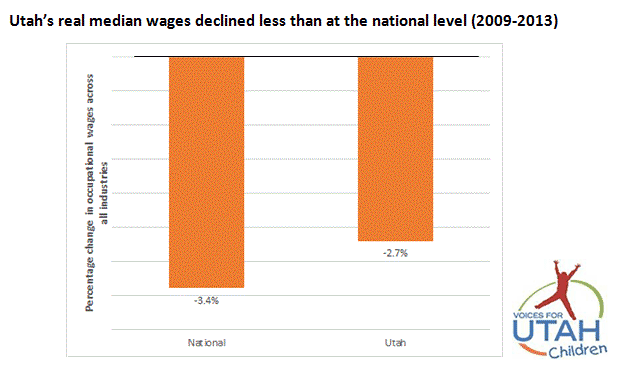 Utah wages have recovered from the Great Recession more quickly than the nation as a whole but remain below pre-recession levels. Averaged across all occupations, the real (inflation-adjusted) median wage in Utah was 2.7% lower in 2013 than it was in 2009, the peak year for wages. At the national level, things are even worse, with wages down by 3.4%.
Utah wages have recovered from the Great Recession more quickly than the nation as a whole but remain below pre-recession levels. Averaged across all occupations, the real (inflation-adjusted) median wage in Utah was 2.7% lower in 2013 than it was in 2009, the peak year for wages. At the national level, things are even worse, with wages down by 3.4%.
Wage inequality has grown in Utah. In both Utah and nationally, lower-wage occupations saw significantly larger declines in their real median wages than did mid-wage and higher-wage occupations, comparing 2009 to 2013. Occupations in the top three quintiles saw their median wages decline by about 1-1.5%. By contrast, occupations in the bottom two quintiles saw their median wages decline by 4-6%, and by more in Utah than nationally. This finding is consistent with the persistently elevated poverty rates that Utah has experienced since the recession ended.
New jobs in Utah pay much less than the ones they replaced. Jobs lost from 2008 Q1 to 2010 Q1 had an average wage of $53,277 while jobs gained from 2010 Q2 to 2014 Q2 had an average wage of $41,342, a decline of about 22%. This is largely due to the fact that higher-wage construction and manufacturing sectors saw significant job losses during the recession, while the fastest growing job sectors since then have included lower paying industries such as health care and retail trade.
Encouraging news on full-time/part-time: The share of the labor force working part time has dropped from a post-recession peak of 26% in 2012 to about 21% in 2014, which is below pre-recession levels. Involuntary part time levels, though, are still slightly higher than pre-recession levels at roughly 3% last year.
Productivity up, but wages down: Along with the nation as a whole, Utah is experiencing a troubling gap between productivity growth and wage growth. While the real median wage in Utah remains below its pre-recession peak, Utah saw 2.5% annual growth in private sector productivity over the time period 2009-2012.
OVERALL ECONOMIC OUTPUT
Recovery in overall economic output per capita in Utah remained behind the national recovery as of the end of 2013, the last year for which this data is available. Per capita real GDP peaked in Utah at $45,652 in 2007 and reached $45,165 in 2013, while for the nation as a whole, the comparable figures are $49,213 in 2007 and $49,115 in 2013. Thus, in 2013, the US was at 99.8% of the pre-recession level, while Utah was at 98.9%. Utah ranked 35th among the states by this measure of economic recovery.
View the complete report:
Nurse Family Partnership
Nurse Family Partnership (NFP) is a voluntary evidenced-based community health program that provides ongoing home visits (from pregnancy through age 2 of the child) from a registered nurse to low-income, first time mothers to provide the care and support they need to have a healthy pregnancy, be a responsible and caring parent, and to become more economically self-sufficient. A nurse visits the women approximately weekly and bi-monthly during their pregnancy and after birth, and then monthly visits during the first two years of their children’s lives. The program is a two-generation intervention and improves outcomes for both the mother and the child. NFP produces very strong outcomes for very high risk, low-income populations.
Economic analyses performed by the Washington State Institute for Public Policy, the Brookings Institute and the Rand Corporation determined that NFP provides a return on investment for taxpayers of $2.37 to $5.70 (high-risk population) per $1 invested in the program.
Download the printer-friendly report:
Nurse Family Partnership
Proven Outcomes
National outcomes associated with NFP, verified through independently evaluated randomized controlled trials, include long term family improvements in health, child welfare, education and self-sufficiency. When brought to scale, NFP can achieve:
• 23% reduction in smoking during pregnancy
• 26% reduction in pregnancy-induced hypertension
• 18% reduction in first pre-term births
• 58% reduction in infant deaths
• 30% reduction in second teen births
• 37% reduction in childhood injuries treated in emergency departments up to age 2
• 30% reduction in child maltreatment
• 38% reduction in language delay of the child by age 2
• 45% reduction in crimes and arrests, ages 11-17
• 51% reduction in alcohol, tobacco and marijuana use, ages 12-15
• 15% reduction in TANF and Food Stamp payments
• 9% reduction in Medicaid costs through age 1
Locally, Salt Lake County has a small NFP program. In 2012, 10.68% of the comparable Medicaid clients had a preterm delivery, compared to 7.5% of NFP clients, a reduction in incidence of 30%. Preterm babies require expensive medical services and a 30% reduction in incidence results in significant cost savings to Medicaid. In addition, the following outcomes for the mother have been documented in Salt Lake County:
• 52.5% increase in employment of clients younger than 18 after starting the program
• 18.9% increase in employment of clients 18 and older after starting the program
• 40% decrease in maternal smoking
• 50% reduction in reported incidence of domestic violence during pregnancy
Government Cost Savings and Avoidance
The outcomes listed above produce significant cost savings in Medicaid, Criminal Justice, Child Welfare, Food Stamps and TANF. Based on national data, Medicaid is the largest recipient of cost savings per family served (55% of cost savings accrue to Medicaid).
Nurse Family Partnership in Utah
The Office of Home Visiting in the Utah Department of Health received $1,097,713 in federal funding through the Maternal, Infant and Early Childhood Home Visiting (MIECHV) Program for Fiscal Year 2013. Of that, $300,000 was allocated to Nurse Family Partnership to serve 75 families in Salt Lake County (the remaining $700,000 was allocated to Parents as Teachers (PAT) - a home-visiting school readiness program). The average cost per family per year for NFP is $4,000. In 2012 (the most recent data available), 4,867 mothers were eligible for NFP statewide. Based on this, an investment of $19,468,000 would be necessary to serve all eligible families.
Recommendation
Voices for Utah Children recommends an ongoing state appropriation of $2,000,000 per year for Nurse Family Partnership, to serve 500 high risk, low-income first time mother statewide. To date, 21 states have appropriated state funds for NFP and/or home visitation.
More Information
A Two-Generation Strategy: Healthy Parents and Healthy Kids

While the vast majority of low-income families with children have at least one full-time worker, most do not qualify, or cannot afford, employer or individual market health insurance plans. Public health coverage programs can equally be out of reach. In most states, Medicaid and CHIP provide coverage to children and pregnant women, but largely exclude parents. However, an extensive body of research shows that when these programs provide coverage to both children and their parents, the entire family benefits.
Download the printer-friendly version of the report here:
A Two-Generation Strategy: Healthy Parents and Healthy Kids
Obviously, covering low-income parents increases their own insurance coverage and access to care. But the benefits do not stop at mom and dad. When parents have access to Medicaid, their Medicaid and CHIP eligible children are much more likely to get enrolled in coverage. Further, parental Medicaid coverage leads to improved use of health care for children, such as preventive care.
Parents living in states that have expanded Medicaid have seen nearly a 33% drop in the rate of parents living without health insurance. States that have not expanded Medicaid have seen no significant change in the rate of uninsured parents.
Medicaid Expansion: Parents and Children Benefit
Partly in reaction to this research, the Affordable Care Act (ACA) required states to move from Medicaid’s old categorical and individual centric approach to a more family centric program that would provide coverage to low-income children and parents alike. The 2012 United States Supreme Court decision that upheld the overall constitutionality of ACA, changed this section of law. Instead of mandating that states provide adults Medicaid coverage, the Court gave states the option to provide Medicaid coverage.
Over half of the states, including the District of Columbia, have expanded Medicaid for parents and other low-income adults. Unfortunately many states, including Utah, have not yet decided to expand Medicaid coverage to adults—and as a result, retained their individual centric Medicaid programs and higher rates of uninsured adults.
How Expansion Would Help Utah Families
Studies have repeatedly shown that health care coverage has a myriad of positive effects for families. Whether that coverage be private employer plans or a public Medicaid program, families’ financial security, ability to work, and the health of parents and children improve when adults have health insurance.
People with Medicaid coverage fare much better than uninsured on measures of access to care, utilization, and unmet health needs. Children enrolled in Medicaid, for example, are more likely to receive well-child care and are significantly less likely to have unmet or delayed needs for medical care, dental care, and prescription drugs due to cost.
Research suggests that Medicaid coverage has similar benefits for adults. Mothers covered by Medicaid are much more likely than low-income uninsured mothers to have a usual source of care, a doctor visit, a dental visit, and to receive cancer screening services. Adults covered by Medicaid are more likely than uninsured adults to report health care visits overall and visits for specific types of services. They are also more likely to report timely care and less likely to delay, or go without, needed medical care because of cost.
Further, out-of-pocket spending would decrease dramatically for low-income uninsured adults—almost four-fold on average, if they had access to Medicaid.
Recently, the Oregon Health Insurance Experiment has provided real life evidence about the positive impact of Medicaid coverage for low-income uninsured adults. Oregon had a lottery for a limited number of a slots in their Medicaid program for adults. This provided researchers the opportunity to look at the differences between adults who received Medicaid coverage and those who remained uninsured. Results from the Oregon experiment found that:
• 70% of enrollees were more likely to have a regular place of care
• 55% of enrollees were more likely to have a regular doctor
• Catastrophic out-of-pocket spending (health costs that exceed 30% of income) was nearly eliminated
• Any type of medical debt was reduced by more than 20%
Expanding coverage could have a direct impact on the health of children as well. Low-income adults are generally sicker than higher income adults. They suffer from increased likelihood of depression and other health issues that can lead to greater risk of their kids experiencing toxic stress. Medicaid expansion may help reduce this risk.
Unfortunately, low income adults in Utah are not experiencing these benefits of health coverage because the state has not yet chosen to expand Medicaid.
The data shows this is a significant problem in Utah where the story of uninsured adults is starkly different than the story of uninsured kids. Thirty-nine percent of adults below 138% of poverty and 43% of adults below poverty are uninsured in Utah. This compares to an uninsured rate of only 19% for adults with incomes above 138% of poverty.
The experience that states have had with children shows that providing access to Medicaid can dramatically reduce uninsured rates. The uninsured rate for children in Utah in households with incomes below 138% is only 18%.
The impact of Medicaid expansion does not stop with the adults who would gain coverage. Although much of the advocacy efforts surrounding Medicaid Expansion have focused only on the individual adults who would gain coverage, the reality is that over half of the expansion population is in a family (two or more related individuals), and nearly 40% are parents of children under the age 18. Providing health coverage to these adults in families will have a positive impact on everyone in that family.
Another misconception about the expansion population is their employment status. The fact is that 87% of families who would benefit from expansion include at least one working parent and 61.5% have at least one parent working full-time.
Unfortunately these families either do not have an offer of employer sponsored coverage, or cannot afford the employer sponsored insurance that is available. Only 29% of adults below 138% of poverty are enrolled in an employer sponsored health insurance plan.
Conclusion
Expanding Medicaid in Utah will strengthen Utah families. The improved health and financial security from providing health coverage to parents will greatly improve the opportunity to stop the cycle of intergenerational poverty.
Voices for Utah Children is proud to be a part of the Aspen Institute Ascend Network. The goal of the Aspen Institute Ascend Network is to mobilize empowered two-generation organizations and leaders to influence policy and practice changes that increase economic security, educational success, social capital, and health and well-being for children, parents, and their families. Learn more at http:/ /ascend.aspeninstitute.org/network
Attendance and the Early Grades: A Two-Generation Issue
Chronic Absence is a Two-Generation Problem
Policies that help parents keep kids in school, such as family leave policies and effective transportation systems; coupled with programs that help the child, such as attention to bullying; and improved policies at the school level, such as collecting the right data and working with families to identify barriers to school attendance will ensure that every child succeeds.
"The reality is an absence is an absence, excused or not, and that child is not in that classroom benefiting from the instruction on that day. We have to work in our community, with our schools and our families to build a culture of attendance."
Ralph Smith, Executive Vice President, Annie E. Casey Foundation
Attendance and the Early Grades: A Two Generation Issue
Chronic absence, missing 10 percent of the school year or more, is an early warning indicator of academic trouble for students and later;dropout. Excused and unexcused absences easily add up to too much time lost in the classroom. Students are at risk academically if they miss 10 percent of the school year, or about 18 days. Once too many absences have occurred, it affects learning, regardless of whether absences are excused or unexcused.
The map below shows the percent of elementary school students who were chonically absent in school year 2013. On average, no district had less than 90 percent of their students absent on a given day, despite exceptionally high rates of chronic absence in some schools and districts. Clearly, average daily attendance can mask a chronic absence problem.
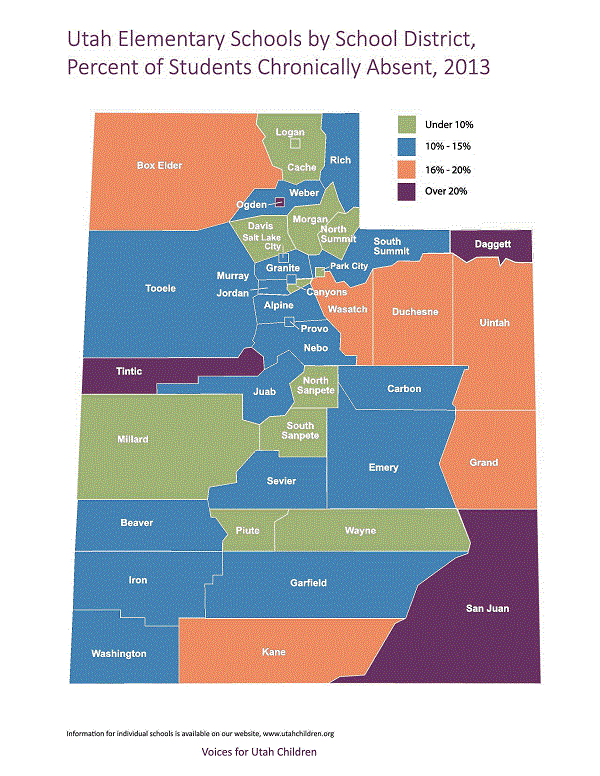

Reducing chronic absence can help close achievement gaps. Chronic absence especially affects achievement for low-income students who depend more on school for opportunities to learn. Because they are more likely to face systemic barriers to getting to school, low-income children, many of whom are children of color, have higher levels of chronic absence starting as early as kindergarten.
A 2012 research brief by the Utah Education Policy Center that looked at the percent of chronically absent students by school year, found that kindergarten and first grade students tended to be chronically absent more often than their older elementary school peers. Further, on average, being chronically absent in one grade increased the odds of being chronically absent in the next grade by nearly 13 times. For each year that a student was chronically absent, his or her odds of dropping out nearly doubled. Studies from multiple states have shown that chronically absent high school students are less likely to graduate. Improving student attendance is an essential, cost-effective but often overlooked two-generation strategy for ensuring that students are on-track to learn and succeed, and to decrease the chance of living in poverty as adults.
Chronic absence does not just affect the students who miss school. If too many students are chronically absent, it slows down instruction for other students, who must wait while the teacher repeats material for absentee students. This makes it harder for students to learn and teachers to teach.
CHRONIC ABSENCE IS A RESULT OF A COMBINATION OF FACTORS: SCHOOL, FAMILY AND COMMUNITY
All schools enroll some students who have injuries or illnesses leading to frequent absences, and schools should know who these students are and design individual strategies to support them. Schools where five percent of students are chronically absent do not have systemic attendance failures. However, in schools where 20 percent of students are chronically absent, the extent to which schools, families and communities each might play a contributing role needs to be considered.
While illness is a leading factor in chronic early absence, others such as poverty, teenage parenting, single parenting, low maternal education levels, unemployment, poor maternal health, and household food insecurity all can affect school attendance. The 2012 Utah Education Policy Center Policy research brief found that students from low-income homes were 90 percent more likely to be chronically absent. Students who are absent from school miss opportunities to learn and develop positive relationships within the school community. During the early elementary school years, children develop important skills and approaches to learning that are critical for ongoing school success. Through their experiences in K-3 classrooms, children build academic, social-emotional and study skills. Children who are chronically absent in kindergarten show lower levels of achievement in math, reading and general knowledge in first grade.
Children who are homeless or formerly homeless experience poor educational outcomes related to school absenteeism and mobility. Other families may be dealing with serious problems (e.g. mental illness, child or domestic abuse, incarceration of a parent, etc.) that make school attendance difficult because family life has been disrupted and public agencies and schools lack a coordinated response.
Chronic absenteeism also can result from poor quality education, ambivalence about or alienation from school, and chaotic school environments, including high rates of teacher turnover, disruptive classrooms and/or bullying.
Improving student attendance is an essential, cost-effective but often overlooked strategy for ensuring our students are on-track to learn and succeed. While addressing some attendance barriers- such as health, poor transportation, and unstable housing- can require longer-term strategies, everyone can make a difference by helping students and families understand that going to school every day and avoiding absences whenever possible is critical to realizing success in school and success in life.
Voices for Utah Children is proud to be a part of the Aspen Institute Ascend Network. The goal of the Aspen Institute Ascend Network is to mobilize empowered two-generation organizations and leaders to influence policy and practice changes that increase economic security, educational success, social capital, and health and well-being for children, parents, and their families. Learn more at http:/ /ascend.aspeninstitute.org/network
Healthy Utah Poll Results
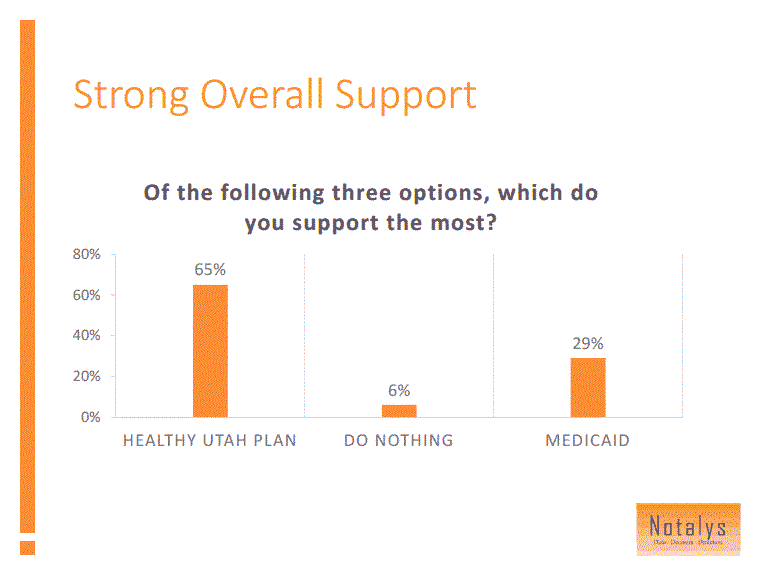 The Healthy Utah Poll was commissioned by a group of Utah civic groups interested in gauging support for Governor Herbert’s Healthy Utah plan. The poll was conducted by Dan Jones & Associates on a sample of 623 Utah voters during May and June, 2014. The full data and methods were then shared with Notalys for independent analysis. Notalys also consulted with the Dan Jones project leader on the development of the survey instrument. This report is the first set of research findings based on the poll. Complete poll results are found in this report along with a description of methods and an analysis of the results. The poll gives a clear and compelling summary of how Utah voters see the Healthy Utah plan, particularly in comparison to other options, such as a full Medicaid Expansion.
The Healthy Utah Poll was commissioned by a group of Utah civic groups interested in gauging support for Governor Herbert’s Healthy Utah plan. The poll was conducted by Dan Jones & Associates on a sample of 623 Utah voters during May and June, 2014. The full data and methods were then shared with Notalys for independent analysis. Notalys also consulted with the Dan Jones project leader on the development of the survey instrument. This report is the first set of research findings based on the poll. Complete poll results are found in this report along with a description of methods and an analysis of the results. The poll gives a clear and compelling summary of how Utah voters see the Healthy Utah plan, particularly in comparison to other options, such as a full Medicaid Expansion.
Download the complete report:
Key findings from the poll analysis
Widespread Support
- When compared with the option of doing nothing, 88% of Utah voters prefer the Healthy Utah plan, and 70% prefer Healthy Utah compared to a full Medicaid expansion.
- Healthy Utah has strong support across the state and among all demographic groups. Support is high for all age, education, race, gender, education and income categories.
No Partisan Divide
- Conservative Republicans support Healthy Utah. Among voters who identify as Republicans, 64% of those who are “very conservative” support the Governor’s plan, while just 13% oppose the plan.
- In general, support among Republicans is higher for Healthy Utah than it is among Democrats, since more Democrats favor Medicaid expansion.
Support for Affordable Health Care
- About 9% of likely voters are currently uninsured, even after healthcare.gov went into effect. A majority (54%) of voters know someone who is uninsured.
- Utahns think health insurance is very important, and, more surprisingly, 83% believe “all legal Utah residents should have access to affordable health insurance.”
- Utah voters believe that individual responsibility is important when it comes to insurance, but they are also supportive of government assistance for those who cannot afford coverage. Of the
- 65% of voters who agree that “individuals and families should generally be responsible for meeting their own healthcare needs,” 80% also agree with the statement that “individuals who are unable to afford health insurance should receive help from government sources.”
- Utahns are not opposed to a federal role in health care. 71% believe it is appropriate for the state to accept federal assistance in health care.
Support for Healthy Utah Plan Features
- A significant majority of voters are interested in the issue of health care, but only about 40% have heard of the new Healthy Utah plan thus far. When the details of the plan are provided, voters are in strong support.
- Utah voters strongly support the individual features of the Healthy Utah plan. Respondents say that the following features of the plan make them more likely to support it than they would otherwise:
- 59% are more likely to support the plan because it requires individuals to pay premiums and co‐pays (10% are less likely).
- 59% are more likely to support the plan because it provides private health insurance for people with low incomes rather than enrolling them in traditional Medicaid (14% are less likely).
- 68% are more likely to support the plan because it allows greater flexibility for how Utah spends federal dollars than allowed under traditional Medicaid (10% are less likely).
Opposed to Inaction
- The strongest consistency in the poll is that voters are very opposed to the status quo of doing nothing. Democrats are more inclined to do a Medicaid expansion, while Republicans support Governor Herbert’s plan. But both groups oppose the status quo. In a three‐way comparison, only 6% of the state voters prefer doing nothing.
- If Healthy Utah is rejected by federal officials, 65% would support a new Utah‐specific solution, and 28% support a Medicaid expansion. Only 7% would favor doing nothing.
- And, 54% of voters indicate they would be more likely to vote for legislators who support Healthy Utah. Only 14% indicate they would be less likely to vote for a legislator who supported the plan.
Poll Take‐Aways
- Utahns are overwhelmingly supportive of the features of Governor Herbert’s Healthy Utah plan.
- Utahns value individual responsibility, but both Republicans and Democrats are strongly supportive of a government role in assisting low‐income individuals to obtain health insurance.
- What Utahns are against, more than anything, is doing nothing.
A Two-Generation Strategy: Right from the Start
Download and print the issue brief here:
A Two Generation Strategy: Right from the Start
This is the second in a series of issue briefs focused on two-generation strategies to reduce poverty supported by Ascend: the Aspen Institute.
The first issue brief in this series is available here:
A Two-Generation Approach to Ending Poverty in Utah
Full Text
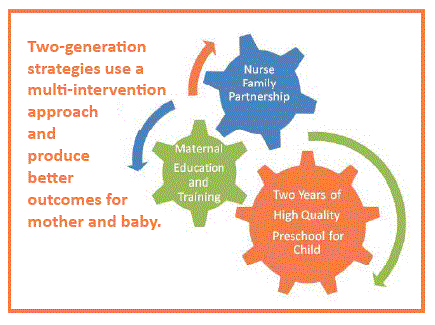
A two-generation, multi-intervention strategy for single, first-time pregnant women in poverty is being developed by Salt Lake County. The three proposed interventions are:
• Nurse Family Partnership
• Education and training for the mother, and
• Two years of high quality preschool for the child beginning at 3 years of age
This combination of interventions is intended to improve the health of the mother and baby, reduce toxic stress, improve child welfare, economic self-sufficiency and the long term life prospects of the child.
COLLABORATION AND INNOVATION
Salt Lake County, the largest in Utah with a population of 1,032,2261, is planning to expand access to the Nurse Family Partnership (NFP). According to the County, approximately 1,100-1,500 women meet the eligibility requirements for NFP. However, only 100 women are currently being served.
Nurse Family Partnership is an evidenced-based community health program that provides ongoing home visits from pregnancy through age 2 of the child by a registered nurse to low-income, first time mothers to provide the care and support that they need to have a healthy pregnancy, be a responsible and caring parent, and to become more economically self-sufficient. Outcomes associated with NFP include long-term family improvements in health, child welfare, education and self-sufficiency.
More than 35 years of evidence from randomized, controlled trials prove this maternal health program’s effectiveness guiding low-income, first-time moms and their children to successful futures. By developing strong family foundations, the Nurse Family Partnership establishes better, safer, and stronger communities for generations to come.
NFP assists clients in returning to their local high school, alternative high school (which usually offers childcare services), or obtaining a GED. They help them with their college applications and suggest ways to finance schooling either through scholarships or PELL grants. NFP also works with the Utah Department of Workforce Services (DWS) Education and Training programs. The nurses encourage their clients to utilize programs which assist financially with completion of a high school diploma, GED, or ESL. NFP encourages participants to use DWS career planning services, take advantage of DWS financial incentives for setting and achieving educational goals, as well as assistance with childcare while
completing their education.
To supplement the education and training referrals performed by NFP, Salt Lake County plans to collaborate with the public libraries to offer Career Online High School to NFP participants in order to promote higher educational attainment and economic self-sufficiency. Career Online High School offers students the opportunity to earn an accredited high school diploma while learning real-world career skills. An accredited, private online school district, Career Online High School is specifically designed to re-engage adults into the education system and prepare them for entry into post-secondary education or the workforce. It is committed to preparing students for careers and post-secondary career education by delivering high-quality, supportive, and career-based online education. Career Online High School gives students the opportunity to earn an accredited high school diploma and credentialed career certificate. Students graduate with the tools to take the next step in their careers or career-education.
COLLABORATION BETWEEN SALT LAKE COUNTY AND THE DEPARTMENT OF WORKFORCE SERVICES
Salt Lake County and DWS will partner to expand access to Nurse Family Partnership, as well as education, training and employment opportunities for the participants. Through the intergenerational poverty focus of DWS, eligible women in Salt Lake County and those classified as living in “intergenerational poverty” will be the target population for the expansion. Additionally, DWS is interested in using Temporary Assistance for Needy Families (TANF) funds to increase access to NFP for this population.
FINANCING STRATEGY
Currently, funding for NFP in Salt Lake County is provided by County funds, Title V-Maternal and the Child Health Block Grant, a grant from the Department of Child and Family Services through the Community-Based Child Abuse Prevention (CBCAP) federal funding, and the Maternal, Infant and Early Childhood Home Visiting (MIECHV) Program created by the Patient Protection and Affordable Care Act of 2010.
To fund the expansion of NFP, Salt Lake County is exploring a blended funding strategy utilizing County funds, federal TANF funds through the collaboration with DWS, and investor funds through an innovative strategy called “Pay-for-Success” or social impact financing.
Under a “Pay-for-Success” financing model, there is an arrangement between one or more government agencies and an external organization where the government specifies the outcomes and promises to pay the external organization a pre-agreed amount if it is able to achieve the outcomes.3 Private commercial and philanthropic investors provide the upfront capital through the external organization to expand services for proven interventions with effective track records that either achieve desired outcomes and/or reduce the cost of later services to government. Outcome measures, such as reduction in preterm births and the spacing of second births, as well as reductions in other areas such as child maltreatment and criminal justice, in the case of NFP, are established and agreed upon by the parties. If the performance measures are achieved, the County would pay back the investors with interest. However, if the outcomes are not achieved, the investors may lose all or some of their investment. Several states, including North Carolina and New York State, and local jurisdictions, such as San Francisco, are exploring the expansion of NFP through social impact financing.
Salt Lake County participated in a proof of concept Results-Based Financing contract (a local term for Pay for Success) for high quality preschool in Utah for the 2013-2014 school year. Six hundred children who were identified as economically disadvantaged were funded through a Pay-for-Success contract. Goldman Sachs Bank and J.B. Pritzker provided the upfront investment. The United Way of Salt Lake and Salt Lake County provided the funds to repay the investors based on the performance metric of reducing the number of children funded through the contract who will need special education services in k-6. The project was announced during the Clinton Global Initiative Conference in June 2013. It is the first social impact loan in the U.S. to finance preschool.
THE PAY FOR PERFORMANCE ACT
On July 30, 2014, U.S. Senator Orrin Hatch (R-Utah), Ranking Member of the Senate Finance Committee and Senator Michael Bennet (D-Colorado), member of the Senate Finance Committee, introduced the Pay-For-Performance Act. The legislation is a companion bill to the Young-Delaney Social Impact Bond Act in the House of Representatives. The Pay-for-Performance Act directs resources to states and local communities to support innovative public-private partnerships to tackle social and public health challenges, while ensuring a smarter, more efficient use of tax dollars.
“The Pay-for-Performance Act gives policymakers a critical, evidence-based strategy for dealing with major societal challenges. By connecting the tools of impact investing to a ‘what works’ approach, this bill takes us one step closer to a smarter, leaner, results focused government. Senators Bennet and Hatch should be commended for providing a bi-partisan, national blueprint for cross sector investments in the outcomes our communities and country need.” Melody C. Barnes, former Director, White House Domestic Policy Council.
CONCLUSION
Although every birth is a major event and every child warrants special attention, home visiting for first time, low-income expectant mothers and their infants is especially beneficial because it provides information and support early in family formation and improves a woman’s ability to effectively parent. Combining home visitation with additional educational and improved employment opportunities leverages positive outcomes for both the mother and the child.
Additionally, implementing or expanding home visiting programs may reduce costs and increase the efficiency of care delivery for managed care organizations (MCO’s) and other health insurance providers. Evidence based home visiting programs have been shown to reduce health care costs by preventing complications in pregnancy, reducing injuries and maltreatment, enhancing maternal and child health through prevention and early detection and promoting efficient use of the health care system.
Two-generation approaches such as Nurse Family Partnership that include providing education and training for mothers are examples of strategies to meet the needs of vulnerable children and their parents.
Voices for Utah Children is proud to be a part of the Aspen Institute Ascend Network. The goal of the
Aspen Institute Ascend Network is to mobilize empowered two-generation organizations and leaders
to influence policy and practice changes that increase economic security, educational success, social
capital, and health and well-being for children, parents, and their families.
Learn more at http://ascend.aspeninstitute.org/network

